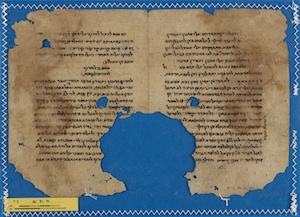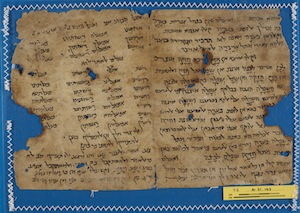A medieval Karaite pedagogical grammar of Hebrew
By Nadia Vidro
The Taylor-Schechter Collection contains many important literary and documentary fragments of Karaite origin. Yet how did these fragments find their way into a collection that stems from the genizah of a Rabbanite synagogue? Two routes seem possible. Although the history of Rabbanite — Karaite relations is not devoid of bitter polemics and conflicts, in 10th-12th-century Egypt the communities lived peacefully side by side, connected through intermarriage, political alliances and business ties. Such close connections between the Rabbanite and the Karaite communities may be one reason why we find Karaite fragments in the T-S Collection.
A second, completely different route, may have opened up in the 19th century. A few decades before Solomon Schechter emptied and brought to Cambridge the contents of the Ben Ezra Synagogue’s genizah, a similar enterprise was undertaken by the most famous Karaite manuscript collector Abraham Firkovitch. In 1864 Firkovitch opened the genizah chamber of the Dār Simḥa Synagogue, the main Karaite synagogue in Cairo. The contents of this very large genizah now form one of the most important collections of Karaite manuscripts, namely, the second Firkovitch Collection, preserved in the Russian National Library in St Petersburg. Whereas the genizah of the Ben Ezra Synagogue was a repository for obsolete writings and contained mainly fragmentary material, the genizah of the Dār Simḥa Synagogue seems to have grown out of the synagogue’s library as well as out of other older Karaite synagogal libraries inherited by the Dār Simḥa. It contained mainly complete codices that were stored in an accessible way. Unlike Schechter, who upon examining the contents of the Ben Ezra Synagogue’s genizah felt that he ‘liked it all’ and moved its entire contents to Cambridge, Firkovitch carefully sorted the contents of the Dār Simḥa genizah, choosing what he believed to be the most complete and valuable manuscripts. The rest of the manuscripts, fragmentarily preserved, were sold to antique dealers or to scholars and collectors who visited the Karaite genizah. It is, thus, not impossible that some Karaite fragments now in the T-S Collection, and especially literary fragments, pages of old Karaite books, stem from the Dār Simḥa genizah and were acquired by Schechter from this synagogue. This would explain why separate folios that join with the manuscripts in the Firkovitch Collection can be found in the T-S Collection and in other genizah collections worldwide.
One of the Karaite works that is preserved both in the collections of Firkovitch and the T-S is a medieval treatise on the grammar of Biblical Hebrew, Kitāb al-ʿUqūd fī Taṣārīf al-Luġa al-ʿIbrāniyya (‘Book of Rules regarding the Grammatical Inflections of the Hebrew Language’). Kitāb al-ʿUqūd was composed in Jerusalem in the middle of the 11th century by an anonymous contemporary of the Karaite grammatical luminary Abū al-Faraj Hārūn ibn Faraj. This book is particularly interesting because it appears to be the first Karaite pedagogical grammar of Hebrew, a concise description of Hebrew morphology and syntax prepared specifically to cater for the level of knowledge and the learning needs of students at the beginning of their study of the Hebrew language. Remarks such as ‘this can often be obscure for beginners’ or ‘I considered it necessary to mention this because I noticed that beginners mix up one with the other’ seem to indicate that the author had first-hand knowledge of problems encountered by beginning students when learning Hebrew. With this target audience in mind he used an array of didactic technics intended to stimulate understanding and ease learning, among them various mnemonics and a set of rules (ʿuqūd) that link different verb forms to one another in order to facilitate the learning of verbal paradigms. For example:
If an imperative begins in a non-root heh and has the form of a transitive verb, the past form will necessarily begin in a heh and the active participle will necessarily begin in a mem…I have coined for this type a mnemonic based on the consonants, not on the vowels, namely הָהֵם, where the hehs represent the imperative and the past, and the mem represents the active participle.
In modern terms, this rule describes the forms of hiph‘il verbs, but medieval Karaites did not base their description of Hebrew verbal morphology on the notion of binyanim, which was developed in the 10th century by Rabbanite grammarians in al-Andalus, and is nowadays familiar to every student of Hebrew.
Fragments of Kitāb al-ʿUqūd that are preserved in the T-S Collection originally belonged to two different codices.
1) T-S Ar. 31.71 (2 folios) and T-S NS 301.64 (1 folio) belong to a copy of the treatise written in the Oriental (Egyptian) semi-cursive script of the late 12th–early 13th centuries. The pages are ruled and the manuscripts are very neat with few corrections, and carefully vocalised. The fragments belong together with T-S Ar. 5.33, T-S Ar. 31.182 and T-S Ar. 31.206, which contain remains of a grammatical commentary on the Prophets. This indicates that this copy of Kitāb al-ʿUqūd was transmitted as part of a professionally executed grammatical-exegetical anthology.
T-S Ar. 31.71v contains a chapter on masculine and feminine letters. The surprising appellations ‘masculine’ and ‘feminine’ for the letters of the alphabet betray distinctly Karaite terminology for the fundamental division of letters into radicals and non-radicals. Feminine letters (al-ḥurūf al-neqeḇot), namely ֗ג֗ד֗ז֗ ח֗ט֗ס֗ ע֗פ֗ץ֗ ק֗ר, are those letters that always occur as radicals. Masculine letters (al-ḥurūf al-zeḵarim), i.e. ֗א֗ב֗ ה֗ו֗ י֗כ֗ל֗ מ֗נ֗ש֗ת, can be either root or non-root letters. Two different anthropomorphic explanations of the terms are offered by medieval grammarians. In Kitāb al-ʿUqūd it is suggested that masculine letters were called so for their ability to attach themselves to feminine letters. This explanation refers to the situation when masculine letters function as affixes added to root letters. Another Karaite grammarian maintained that feminine letters are like women, who always stay at home, and masculine letters are like men, who are at times at home and at times outside. This explanation reflects the fact that feminine letters are always radicals and masculine letters can be either radicals or non-radicals.
T-S Ar. 31.71: 12th or early 13th-century copy of the Book of Rules
2) T-S Ar. 31.143 (2 folios) and T-S Ar. 31.219 (2 folios) belong to a copy of Kitāb al-ʿUqūd that seems to have been preserved in the Genizah, but not in the Firkovitch collection. The fragments are written in the Oriental (Egyptian) semi-cursive script of the second half of the 11th–early 12th century, suggesting that they were copied very soon after the book was written. The pages are not ruled and the majority of the lines slant downwards or have a curve in the middle. The copy exhibits a relatively large number of corrections, mainly deletions of incorrectly copied words or phrases that originated by homœoteleuton, with the corrected version written as the next word on the line right after the cancelled phrase, showing that corrections took place in the process of copying. This copy seems to have been prepared by somebody for his personal use.
T-S Ar. 31.143r contains tables on verb forms with pronominal suffixes. This tabular layout is characteristic of Kitāb al-ʿUqūd and distinguishes it from other known Karaite texts on Hebrew verbal morphology. In the tables all grammatically possible verb form—suffix combinations are recorded and are provided either with an Arabic translation or with a corresponding form of the Arabic verb faʿala ("do"). Sometimes two forms are inflected in parallel. Thus, in T-S Ar. 31.143r one finds a 4-column table on the feminine singular imperative דֹּשִי and the corresponding past form דַּשׁוֹתִי with pronominal suffixes. Columns 1 and 3 contain the inflected Hebrew imperative and past form, and columns 2 and 4 provide the interpretation of the forms through the corresponding Arabic forms of faʿala.
T-S Ar. 31.143: 11th or early 12th-century copy, showing the tabular layout that is characteristic of the Book of Rules
My analysis of grammatical theories and pedagogical strategies reflected in Kitāb al-ʿUqūd has recently appeared in the Cambridge Genizah Studies Series, Brill (Vidro 2011), under the title Verbal Morphology in the Karaite Grammatical Treatise Kitāb al-ʿUqūd fī Taṣārīf al-Luġa al-ʿIbrāniyya. A critical edition and English translation of this fascinating medieval grammar has also just been published in the same series (Vidro 2013), under the title A Medieval Karaite Pedagogical Grammar of Hebrew: a critical edition and English translation of Kitāb al-ʿUqūd fī Taṣārīf al-Luġa al-ʿIbrāniyya.
Bibliography
Ben-Shammai, H., 2010, ‘Is “the Cairo Genizah” a proper name or a generic noun? On the relationship between the genizot of the Ben Ezra and the Dār Simḥa synagogues’, in B. Outhwaite & S. Bhayro (eds), ‘From a Sacred Source’, Leiden/Boston, Brill.
Elkin, Z., M. Ben-Sasson, 2002, ‘Abraham Firkovitch and the Cairo Genizahs in the light of his personal archive’ (Hebrew), Peʿamim 90, pp. 51-95.
Vidro, N., 2011, Verbal Morphology in the Karaite Grammatical Treatise Kitāb al-ʿUqūd fī Taṣārīf al-Luġa al-ʿIbrāniyya, Leiden/Boston, Brill.
Vidro, N., 2013, A Medieval Karaite Pedagogical Grammar of Hebrew: a critical edition and English translation of Kitāb al-ʿUqūd fī Taṣārīf al-Luġa al-ʿIbrāniyya, Leiden/Boston, Brill (forthcoming).
Cite this article
(2013). A medieval Karaite pedagogical grammar of Hebrew. [Genizah Research Unit, Fragment of the Month, September 2013]. https://doi.org/10.17863/CAM.62321
If you enjoyed this Fragment of the Month, you can find others here.
Contact us: genizah@lib.cam.ac.uk
The zoomable images are produced using Cloud Zoom, a jQueryimage zoom plugin:
Cloud Zoom, Copyright (c) 2010, R Cecco, www.professorcloud.com
Licensed under the MIT License


